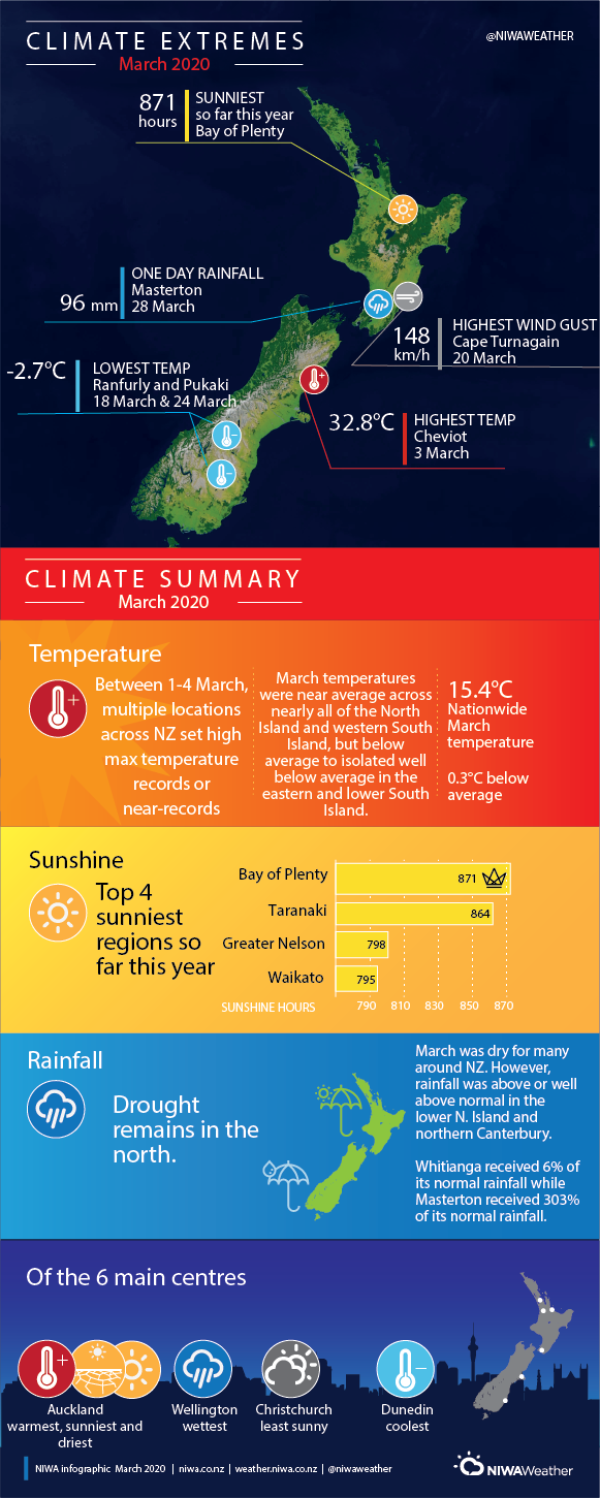Dry for many locations; temperatures near to below average
|
Rainfall |
March was dry for many locations in New Zealand, as below normal (50-79% of normal) to well below normal (<50% of normal) rainfall was observed in much of the upper North Island, Hawke’s Bay, Tasman, Nelson, much of Marlborough, and large parts of Otago. Most notably, Whitianga only received 6% of its normal rainfall in March. Conversely, rainfall was above normal (120-149% of normal) or well above normal (>149% of normal) in the lower North Island, northern Canterbury, and a small portion of western Waikato. Notably, Masterton received 303% of its normal March rainfall. Elsewhere, rainfall amounts were generally near normal (80-119% of normal). |
|
Temperature |
March temperatures were near average (-0.5°C to +0.5°C from average) across a vast majority of the North Island, Tasman, and West Coast. However, below average (0.51-1.20°C below average) and isolated well below average (<1.20°C below average) temperatures were observed across much of the eastern and lower South Island. Isolated above average (0.51-1.20°C above average) to well above average (>1.20°C above average) temperatures occurred near Cape Reinga and Farewell Spit. |
|
Soil Moisture |
As of 1 April, soil moisture levels remained below to well below normal across much of the North Island as well as near Nelson and small parts of the lower South Island. Meteorological drought receded significantly during March, but as of 1 April remained in place across parts of Northland, Auckland, and far northern Waikato. In addition, severe meteorological drought was found across the Coromandel Peninsula. Conversely, soil moisture levels were above to well above normal in the lower North Island and northern Canterbury. |
Overview
March 2020 was characterised by below normal pressure to the northeast of the North Island and above normal pressure to the southeast of the South Island. This pressure setup was associated with a light easterly quarter wind flow anomaly.
March was a dry month for many locations across New Zealand, particularly in the upper North Island where parts of Northland, Auckland, and northern Waikato remain in meteorological drought and severe meteorological drought as of 1 April according to NIWA’s New Zealand Drought Index. Notably, Whitianga only received 6% of its normal March rainfall, and through the first three months of 2020 had received only 24.8 mm of rain compared to a normal of 333 mm (7% of normal). Due to the long-term dryness, on 12 March, Agriculture Minister Damien O’Connor classified the drought in the North Island, upper South Island, and the Chatham Islands as a large-scale adverse event, unlocking up to $2 million in government funding to support farmers and growers through to June 2021 (see Highlights and extreme events for further details). However, heavy rain in the lower North Island and northern Canterbury during 28-30 March resulted in massive soil moisture increases and the cancellation of water restrictions in Christchurch and Banks Peninsula.
March temperatures were near average across nearly all of the North Island and the western South Island. However, due to the easterly wind flow anomaly during the month, eastern and southern portions of the South Island generally saw below average to even isolated well below average temperatures. The nationwide average temperature in March 2020 was 15.4°C, which is 0.3°C below the 1981-2010 March average from NIWA’s seven station temperature series which begins in 1909.
New Zealand has not had a month with below average temperatures (i.e. more than 0.5°C below average) since January 2017, a period of 38 consecutive months.
Further Highlights:
- The highest temperature was 32.8˚C, observed at Cheviot on 3 March. This was the warmest March temperature in New Zealand since 2017.
- The lowest temperature was -2.7˚C, observed at Ranfurly on 18 March and at Pukaki on 24 March.
- The highest 1-day rainfall was 96 mm, recorded at Masterton on 28 March.
- The highest wind gust was 148 km/h, observed at Cape Turnagain on 20 March.
- Of the six main centres in March 2020, Auckland was the warmest, driest, and sunniest, Dunedin was the coldest, Wellington was the wettest, and Christchurch was the least sunny.
- Of the available, regularly reporting sunshine observation sites, the sunniest four locations in 2020 so far are Bay of Plenty (871 hours), Taranaki (864 hours), Greater Nelson (798 hours) and Waikato (795 hours).


